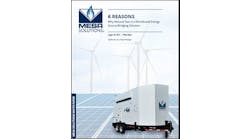June 1, 2011
As a parent, I don’t expect world changing results when I gripe at my kids. I’m happy if they at least leave a path through the dirty clothes on their bedroom floors.
If you’re like that too, you’ll be a little sheepish when you hear the story of inventor and journalist Pierce Hoover. His 13-year-old son, Nash, kept forgetting to shut off the lights, so Hoover made a very big deal about it, the kind that changes the world.
Hoover took Nash to a local gym to ride an exercise bike that measures energy output in watts. He challenged his son to pedal hard enough to generate enough power to light a 100-watt bulb. Nash found that it took a lot of sweat.
“I wanted to instill in him the awareness that electric power, while inexpensive, doesn’t just flow effortlessly from a socket. Electric energy is the product of a complex infrastructure that runs back through the grid to places where big wheels labor and massive boilers consume natural resources, create heat, and emit waste gasses,” said Hoover in his blog at PopSci.com.
Then Hoover and Nash got an idea. Would it be possible to cross the country peddling their way on just a light bulb worth of energy each day?
With a team of engineer friends, the father-son duo built a human-electric hybrid vehicle with a motor fueled by a battery and kinetic energy generated through pedaling. They leave Virginia June 2 to cross the country to Oregon, a 4,500 mile trip, in the cart-like two-seater, which is powered by a 100-watt battery.
It’s going to be a slow, but scenic trip, reports Hoover who works for PopSci’s parent, Bonnier Corporation. Since the vehicle only travels 25 miles per hour at top speed, they cannot use major throughways. Instead, they’ll follow the TransAmerica Bike Trail, which will add about 1,200 extra miles to their journey.
Rationed at 2,400 watts a day, the father and son will take a three hour rest each day as they recharge their batteries and that of the car, which only holds 1,400 watts. They expect to travel about 60 miles per day.
What kind of mileage does the cart get? As much as 1,000 miles per gallon, according to a news release issued by Popular Science Magazine, which is sponsoring the trip along with GE. The father and son have dubbed the trip the “Eco Tour” and say they will spread a message of conservation.
“The Eco Tour is a fantastic example of technological ingenuity combined with personal conviction, and we’re thrilled to bring our readers along for the journey,” said Mark Jannot, Editor-in-Chief of Popular Science.
Okay, so maybe the Saudis aren’t quaking at the sight of Hoover and Nash pedaling down the road. But still, Hoover is likely to make not only his son, but a lot of other people, think in a more meaningful way about producing and using energy.
You can follow their journey at www.popsci.com/ecotour or twitter.com/popsciecotour.
See more of Elisa Wood’s work at www.RealEnergyWriters.com






